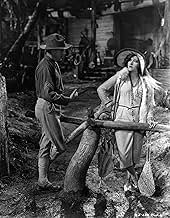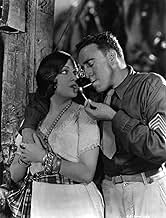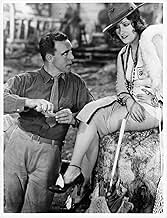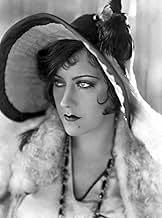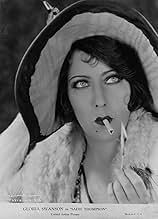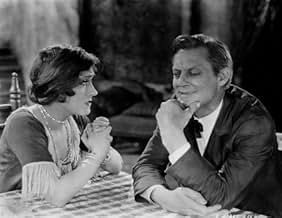VALUTAZIONE IMDb
7,2/10
2900
LA TUA VALUTAZIONE
Una prostituta in cerca di un nuovo inizio diventa l'ossessione di un estremista religioso.Una prostituta in cerca di un nuovo inizio diventa l'ossessione di un estremista religioso.Una prostituta in cerca di un nuovo inizio diventa l'ossessione di un estremista religioso.
- Candidato a 2 Oscar
- 3 vittorie e 2 candidature totali
Charles Sullivan
- Marine
- (non citato nei titoli originali)
Trama
Lo sapevi?
- QuizUnseen for many years because the last reel had decomposed, the final eight minutes have been reconstructed using production stills and title cards, allowing modern audiences to see an approximation of the complete film.
- BlooperAt the beginning of the film, Mr. and Mrs. Davidson each write a quotation in the ship's autograph book. Their handwriting appears identical, revealing that neither actor actually wrote what is shown on screen.
- Citazioni
Sadie Thompson: [screaming at Alfred Davidson] Was I doing you any harm? You bloodthirsty buzzard! Was I? Who gave you the right to pass judgement on me? You psalm-singing louse! You'd tear out your own mother's heart, if she didn't agree with you, and call it saving her soul!
- Versioni alternativeOriginally released at 97 minutes. Out of circulation for decades because the final reel of the picture was destroyed due to film decay.
- ConnessioniEdited into Spisok korabley (2008)
Recensione in evidenza
For those who would pigeonhole Raoul Walsh as an "action master" or "man's director", this small-focus drama with a female protagonist might seem at odds with his image. In fact, while he was a versatile director who could turn out a rousing action scene, it was the drama particularly in the relationships between individuals that was Walsh's greatest strength. Sadie Thompson in fact shows us his mastery of the technique in its purest form.
Walsh himself made the adaptation from the play "Rain", not as easy a task as it sounds a play has to convey action through dialogue, while a silent film does the exact opposite. Sadie Thompson begins with a series of autograph mottos from each character, a rather clumsy way to introduce character. This is immediately followed however with a particularly smooth bit of film-making. We are given a point-of-view shot, as Swanson looks down at the group of soldiers on the shore, then we cut back to her, and the camera pulls back as she descends the gang plank. A few shots later the camera is dollying forward, following Swanson and the soldiers hovering around her. In this handful of shots we are subtly informed of Miss Thompson's profession, but also with those attention-grabbing point-of-view shots and camera movements we, the audience, are placed into the position of the characters. Walsh has drawn us into the story at this crucial establishing moment.
Considering it only really revolves around two developing relationships that between Sadie and Tim, and that between Sadie and Davidson the main part of the film is like a tour-de-force of different ways to shoot interaction between two people. The scenes between Swanson and Walsh are given the customary tenderness of a regular romance, with some delicate shot compositions that give it a natural, harmonious feel. The relationship between Swanson and Barrymore in contrast is full of intensity lots of cuts, faces framed in stark close-up. What is particularly neat, is that all of the major dialogue scenes begin with a fair few title cards getting the unavoidable wordy bits out of the way first but then the dialogue fizzles out and the interaction continues with just the images, back and forth.
Of course, the effectiveness of the drama would be lost without great acting and, yes, this probably is Swanson's finest performance prior to Sunset Boulevard. I think Swanson was at her best when she was really allowed to let go, and put all her energy into a character, and to say she does that here would be an understatement. Lionel Barrymore is fine as the archetypal repressed Christian, a little hammy perhaps but then, he is a Barrymore. And Walsh himself absolutely acts his socks off, actually turning in the deepest performance of the picture, and the fact that his acting days were soon to be cut short is one of several tragedies regarding his career.
Speaking of tragedies, looming over Sadie Thompson is the unfortunate loss of the final reel, which has since been semi-reconstructed with stills and titles. While what we see today suffers from a very noticeable lack of a climax, the dramatic build up comes close to perfection. Considering its small scale and lack of action, Sadie Thompson was apparently a massive popular success. In his autobiography Raoul Walsh quotes several letters he apparently received from prostitutes of various nationalities which, while they may well have been fabricated or exaggerated slightly, are probably accurate at least in tone. By contrast the 1932 talkie version was a flop, despite an equally great cast, testament to Walsh's talent as a director of powerful cinematic drama.
Walsh himself made the adaptation from the play "Rain", not as easy a task as it sounds a play has to convey action through dialogue, while a silent film does the exact opposite. Sadie Thompson begins with a series of autograph mottos from each character, a rather clumsy way to introduce character. This is immediately followed however with a particularly smooth bit of film-making. We are given a point-of-view shot, as Swanson looks down at the group of soldiers on the shore, then we cut back to her, and the camera pulls back as she descends the gang plank. A few shots later the camera is dollying forward, following Swanson and the soldiers hovering around her. In this handful of shots we are subtly informed of Miss Thompson's profession, but also with those attention-grabbing point-of-view shots and camera movements we, the audience, are placed into the position of the characters. Walsh has drawn us into the story at this crucial establishing moment.
Considering it only really revolves around two developing relationships that between Sadie and Tim, and that between Sadie and Davidson the main part of the film is like a tour-de-force of different ways to shoot interaction between two people. The scenes between Swanson and Walsh are given the customary tenderness of a regular romance, with some delicate shot compositions that give it a natural, harmonious feel. The relationship between Swanson and Barrymore in contrast is full of intensity lots of cuts, faces framed in stark close-up. What is particularly neat, is that all of the major dialogue scenes begin with a fair few title cards getting the unavoidable wordy bits out of the way first but then the dialogue fizzles out and the interaction continues with just the images, back and forth.
Of course, the effectiveness of the drama would be lost without great acting and, yes, this probably is Swanson's finest performance prior to Sunset Boulevard. I think Swanson was at her best when she was really allowed to let go, and put all her energy into a character, and to say she does that here would be an understatement. Lionel Barrymore is fine as the archetypal repressed Christian, a little hammy perhaps but then, he is a Barrymore. And Walsh himself absolutely acts his socks off, actually turning in the deepest performance of the picture, and the fact that his acting days were soon to be cut short is one of several tragedies regarding his career.
Speaking of tragedies, looming over Sadie Thompson is the unfortunate loss of the final reel, which has since been semi-reconstructed with stills and titles. While what we see today suffers from a very noticeable lack of a climax, the dramatic build up comes close to perfection. Considering its small scale and lack of action, Sadie Thompson was apparently a massive popular success. In his autobiography Raoul Walsh quotes several letters he apparently received from prostitutes of various nationalities which, while they may well have been fabricated or exaggerated slightly, are probably accurate at least in tone. By contrast the 1932 talkie version was a flop, despite an equally great cast, testament to Walsh's talent as a director of powerful cinematic drama.
I più visti
Accedi per valutare e creare un elenco di titoli salvati per ottenere consigli personalizzati
Dettagli
- Data di uscita
- Paese di origine
- Lingua
- Celebre anche come
- Sadie Thompson
- Luoghi delle riprese
- Two Harbors, Santa Catalina Island, Channel Islands, California, Stati Uniti(some Pago Pago exteriors)
- Azienda produttrice
- Vedi altri crediti dell’azienda su IMDbPro
Botteghino
- Budget
- 650.000 USD (previsto)
- Tempo di esecuzione1 ora 37 minuti
- Mix di suoni
- Proporzioni
- 1.33 : 1
Contribuisci a questa pagina
Suggerisci una modifica o aggiungi i contenuti mancanti

Divario superiore
By what name was Tristana e la maschera (1928) officially released in Canada in English?
Rispondi
